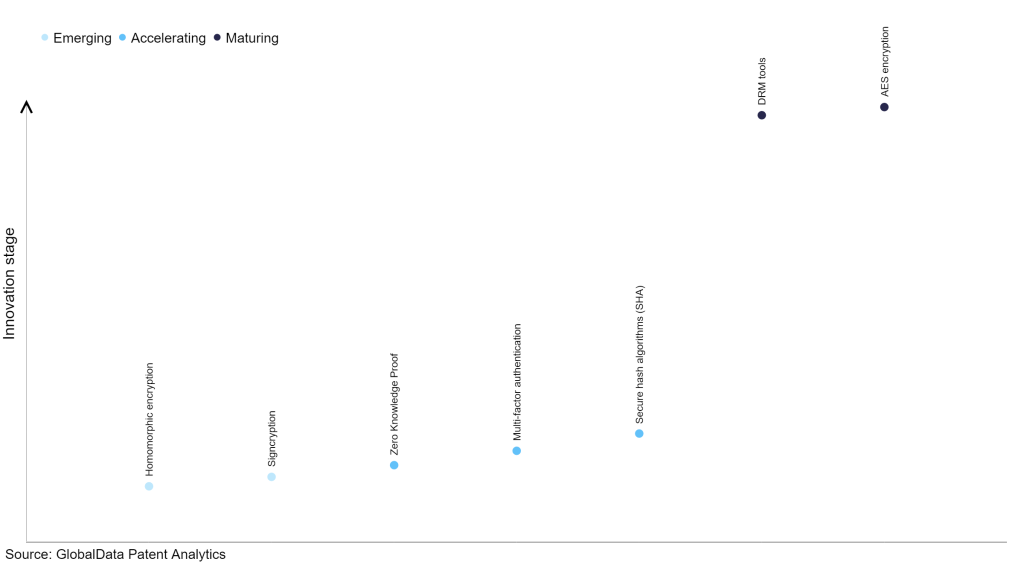The technology industry continues to be a hotbed of patent innovation. Activity is driven by the escalating frequency and sophistication of cyber threats, driving organizations to implement stringent authentication protocols to safeguard their systems and data, and growing importance of technologies such as digital certificates, cryptographic keys, and multi-factor authentication methods to establish a secure and trusted connection. In the last three years alone, there have been over 1.5 million patents filed and granted in the technology industry, according to GlobalData’s report on Cybersecurity in technology: mutual authentications. Buy the report here.
However, not all innovations are equal and nor do they follow a constant upward trend. Instead, their evolution takes the form of an S-shaped curve that reflects their typical lifecycle from early emergence to accelerating adoption, before finally stabilizing and reaching maturity.
Identifying where a particular innovation is on this journey, especially those that are in the emerging and accelerating stages, is essential for understanding their current level of adoption and the likely future trajectory and impact they will have.
185+ innovations will shape the technology industry
According to GlobalData’s Technology Foresights, which plots the S-curve for the technology industry using innovation intensity models built on over 1.6 million patents, there are 185+ innovation areas that will shape the future of the industry.
Within the emerging innovation stage, homomorphic encryption and signcryption are disruptive technologies that are in the early stages of application and should be tracked closely. Zero knowledge proof, multi-factor authentication and secure hash algorithms (SHA) are some of the accelerating innovation areas, where adoption has been steadily increasing. Among maturing innovation areas are DRM tools and AES encryption which are now well established in the industry.
Innovation S-curve for cybersecurity in the technology industry

Mutual authentications is a key innovation area in cybersecurity
Mutual authentication is a procedure in which two parties confirm each other's identities to establish trust and ensure secure communication. This entails a reciprocal verification where both sides authenticate their legitimacy before sharing sensitive information or engaging in transactions.
GlobalData’s analysis also uncovers the companies at the forefront of each innovation area and assesses the potential reach and impact of their patenting activity across different applications and geographies. According to GlobalData, there are 1,050+ companies, spanning technology vendors, established technology companies, and up-and-coming start-ups engaged in the development and application of mutual authentications.
Key players in mutual authentications – a disruptive innovation in the technology industry
‘Application diversity’ measures the number of applications identified for each patent. It broadly splits companies into either ‘niche’ or ‘diversified’ innovators.
‘Geographic reach’ refers to the number of countries each patent is registered in. It reflects the breadth of geographic application intended, ranging from ‘global’ to ‘local’.
Patent volumes related to mutual authentications
Source: GlobalData Patent Analytics
Among the companies innovating in mutual authentication, Sony Group is the leading patent filer. The company’s patents are aimed at an intelligent wearable gadget equipped with sensors capable of gathering both biological data from the user and environmental information. These sensors can capture input, prompting the wearable to recognize a specific task to execute. In cases where the device concludes that the task demands additional capabilities, it can autonomously obtain the required skills from diverse data sources and adjust its configuration to execute the task proficiently. Other prominent patent filers in the space include Huawei and Samsung Group.
In terms of application diversity, Huawei leads the pack, while Qualcomm and DexCom stood in second and third positions, respectively. In terms of geographical reach, Network-1 Technologies held the top position, followed by DexCom and Vodafone Group.
Mutual authentication holds immense significance in cybersecurity as it establishes a two-way verification process, ensuring that both parties involved in a communication are who they claim to be. This robust authentication method provides a critical defence against impersonation attacks and unauthorized access, safeguarding sensitive information and preventing unauthorized transactions or activities. It forms a fundamental pillar in securing digital communications and is essential in protecting sensitive data in industries ranging from finance and healthcare to government and e-commerce.
To further understand the key themes and technologies disrupting the technology industry, access GlobalData’s latest thematic research report on Cybersecurity.
Data Insights
From

The gold standard of business intelligence.
Blending expert knowledge with cutting-edge technology, GlobalData’s unrivalled proprietary data will enable you to decode what’s happening in your market. You can make better informed decisions and gain a future-proof advantage over your competitors.







